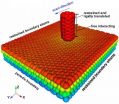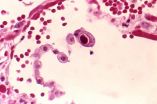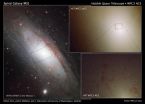(Press-News.org) Similar to the way pavement, softened by a hot sun, will slow down a car, graphene—a one-atom-thick sheet of carbon with wondrous properties—slows down an object sliding across its surface. But stack the sheets and graphene gets more slippery, say theorists at the National Institute of Standards and Technology (NIST), who developed new software to quantify the material's friction.
"I don't think anyone expects graphene to behave like a surface of a three-dimensional material, but our simulation for the first time explains the differences at an atomic scale," says NIST postdoctoral researcher Alex Smolyanitsky, who wrote the modeling program and co-authored a new paper* about the study. "If people want to use graphene as a solid-state lubricant or even as a part of flexible electrodes, this is important work."
With the capacity to be folded, rolled or stacked, graphene is super-strong and has unusual electronic and optical properties. The material might be used in applications ranging from electronic circuits to solar cells to "greasing" moving parts in nanoscale devices.
Friction is the force that resists the sliding of two surfaces against each other. Studying friction at the atomic scale is a challenge, surmountable in only the past few years. The NIST software simulates atomic force microscopy (AFM) using a molecular dynamics technique. The program was used to measure what happens when a simulated AFM tip moves across a stack of one to four graphene sheets (see image) at different scanning rates.
The researchers found that graphene deflects under and around the AFM tip. The localized, temporary warping creates rolling friction or resistance, the force that exerts drag on a circular object rolling along a surface. Smolyanitsky compares the effect to the sun melting and softening pavement in the state where he got his doctoral degree, Arizona, causing car tires to sink in slightly and slow down. The NIST results are consistent with those of recent graphene experiments by other research groups but provide new quantitative data.
Most significantly, the NIST study shows why friction falls with each sheet of graphene added to the stack (fast scanning also has an effect on the friction). With fewer layers, the top layer deflects more, and the friction per unit of AFM contact force rises. The top surface of the stack becomes less yielding and more slippery as graphene layers are added. By contrast, the friction of three-dimensional graphite-like material is virtually unaffected by deformation and rolling friction, and is due instead to heat created by the moving tip.
INFORMATION:
* A. Smolyanitsky, J.P. Killgore and V.K. Tewary. Effect of elastic deformation on frictional properties of few-layer graphene. Physical Review B. Posted online Jan. 9.
Slippery when stacked: NIST theorists quantify the friction of graphene
2012-01-13
ELSE PRESS RELEASES FROM THIS DATE:
NIST standard available for better diagnosis, treatment of cytomegalovirus
2012-01-13
A new clinical Standard Reference Material (SRM) from the National Institute of Standards and Technology (NIST) will help health care professionals more accurately diagnose and treat cytomegalovirus (CMV), a common pathogen that is particularly dangerous for infants and persons with weakened immune systems.
CMV is found in 50 to 80 percent of the population. It is a member of the herpes family of viruses that includes two herpes simplex viruses (the causes of cold sores and genital herpes), the varicella-zoster virus (the cause of chicken pox and shingles) and the Epstein-Barr ...
Stretching exercises: Using digital images to understand bridge failures
2012-01-13
With a random-looking spatter of paint specks, a pair of cameras and a whole lot of computer processing, engineer Mark Iadicola of the National Institute of Standards and Technology (NIST) has been helping the Federal Highway Administration (FHWA), in cooperation with the American Association of State Highway and Transportation Officials (AASHTO), to assure the safety of hundreds of truss bridges across the United States. Iadicola has been testing the use of a thoroughly modern version of an old technique—photographic measurement or "photogrammetry"—to watch the failure ...
NIST releases 2 new SRMs for monitoring human exposure to environmental toxins
2012-01-13
The National Institute of Standards and Technology (NIST), in collaboration with the Centers for Disease Control and Prevention (CDC), has developed two new Standard Reference Materials (SRMs) for measurements of human exposure to environmental toxins. Used as a sort of chemical ruler to check the accuracy of tests and analytic procedures, the new reference materials replace and improve older versions, adding measures for emerging environmental contaminants such as perchlorate, a chemical that the Environmental Protection Agency has targeted for regulation as a contaminant ...
Outlook for an industry that touches 96 percent of all manufactured goods
2012-01-13
The chemical industry, which touches 96 percent of all manufactured goods, is seeing some positive signs for 2012, although the overall outlook is not very rosy. Growing demand for chemicals used in agriculture, electronics, cars and airplanes will boost an industry that generates $674 billion in sales in the U.S. alone, but expiring patents and global economic woes will take a toll. These forecasts and others are in the cover story in the current issue of Chemical & Engineering News (C&EN), the weekly newsmagazine of the American Chemical Society, the world's largest scientific ...
'I feel your pain ...'
2012-01-13
Imagine the following scenarios: a co-worker is spoken to condescendingly, excluded from a meeting, or ignored by a supervisor. How does it make you feel? Do you feel differently depending on whether your co-worker is a man or a woman? According to a new study, workers who witness incivility towards colleagues feel negative emotions – especially when the incivility is aimed at workers of the same sex. The work, by Kathi Miner from Texas A&M University and Angela Eischeid from Buena Vista University, Iowa, is the first to look at the relationship between employees' observations ...
ALMA early science result reveals starving galaxies
2012-01-13
Astronomers using the partially completed ALMA observatory have found compelling evidence for how star-forming galaxies evolve into 'red and dead' elliptical galaxies, catching a large group of galaxies right in the middle of this change.
For years, astronomers have been developing a picture of galaxy evolution in which mergers between spiral galaxies could explain why nearby large elliptical galaxies have so few young stars. The theoretical picture is chaotic and violent: The merging galaxies knock gas and dust into clumps of rapid star formation, called starbursts, ...
OU researchers predict the next big thing in particle physics: Supersymmetry
2012-01-13
A better understanding of the universe will be the outgrowth of the discovery of the Higgs boson, according to a team of University of Oklahoma researchers. The team predicts the discovery will lead to supersymmetry or SUSY—an extension of the standard model of particle physics. SUSY predicts new matter states or super partners for each matter particle already accounted for in the standard model. SUSY theory provides an important new step to a better understanding of the universe we live in.
Howard Baer, Homer L. Dodge Professor of High Energy Physics in the OU Department ...
NASA sees Tropical Storm Heidi approaching Australia's Pilbara coast
2012-01-13
Tropical Storm Heidi is forecast to make landfall today along the Pilbara coast of Western Australia as warnings pepper the coast. NASA's Aqua satellite passed overhead early in the day and captured a visible image showing Heidi's center still north of the Pilbara coast, while her outer bands continue to bring rainfall and gusty winds to coastal residents.
NASA's Aqua satellite passed over Heidi on January 11, 2012 at 02:30 UTC (Jan. 10 at 10:30 a.m. EST) and the Moderate Resolution Imaging Spectroradiometer captured a visible image of the storm. The image showed that ...
Rare ultra-blue stars found in neighboring galaxy's hub
2012-01-13
Peering deep inside the hub of the neighboring Andromeda galaxy, NASA's Hubble Space Telescope has uncovered a large, rare population of hot, bright stars.
Blue is typically an indicator of hot, young stars. In this case, however, the stellar oddities are aging, sun-like stars that have prematurely cast off their outer layers of material, exposing their extremely blue-hot cores.
Astronomers were surprised when they spotted these stars because physical models show that only an unusual type of old star can be as hot and as bright in ultraviolet light.
While Hubble has ...
Hubble zooms in on double nucleus in Andromeda galaxy
2012-01-13
A new Hubble Space Telescope image centers on the 100-million-solar-mass black hole at the hub of the neighboring spiral galaxy M31, or the Andromeda galaxy, the only galaxy outside the Milky Way visible to the naked eye and the only other giant galaxy in the local group.
This is the sharpest visible-light image ever made of the nucleus of an external galaxy.
The event horizon, the closest region around the black hole where light can still escape, is too small to be seen, but it lies near the middle of a compact cluster of blue stars at the center of the image. The ...




